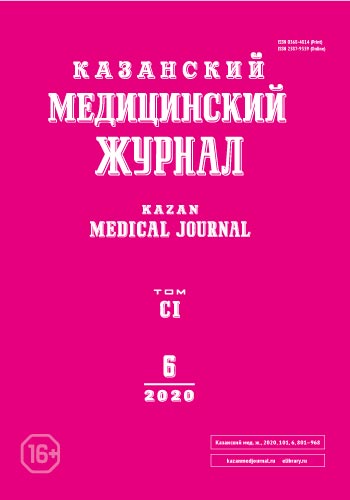Сравнительная характеристика компьютерной томографии и рентгенографии в диагностике тупой травмы грудной клетки
- Авторы: Гасымзаде Г.Ш.1
-
Учреждения:
- Азербайджанский государственный институт усовершенствования врачей им. А. Алиева
- Выпуск: Том 101, № 6 (2020)
- Страницы: 926-929
- Раздел: Обмен клиническим опытом
- Статья получена: 20.03.2020
- Статья одобрена: 16.10.2020
- Статья опубликована: 14.12.2020
- URL: https://kazanmedjournal.ru/kazanmedj/article/view/25804
- DOI: https://doi.org/10.17816/KMJ2020-926
- ID: 25804
Цитировать
Аннотация
Цель. Проведение сравнительного анализа эффективности рентгенологического метода диагностики и компьютерной томографии в выявлении повреждений у пациентов с тупой травмой грудной клетки.
Методы. Были обследованы 68 пациентов с травмой грудной клетки (мужчины и женщины), средний возраст 34,6±7 лет (от 18 до 65 лет). Причинами травмы были дорожно-транспортные происшествия — 37 (54,4%), падение с высоты — 21 (30,8%), тупой удар в грудную клетку — 10 (14,8%). Сравнивали результаты обследования пациентов на рентгеновском аппарате и компьютерном томографе.
Результаты. При рентгеновском обследовании выявлен перелом костей грудной клетки у 24 (35,3%) пациентов, тогда как при компьютерной томографии — в 32 (47,1%) случаях (χ2=1,943; p=0,163). Это даёт возможность констатировать, что при диагностике переломов костей грудной клетки результаты томографии бывают более точными. При компьютерной томографии в 56 (82,4%) случаях диагностированы повреждения органов грудной клетки в виде пневмоторакса и гемоторакса, в то время как при рентгенологическом исследовании пневмоторакс и гемоторакс были обнаружены лишь в 37 (54,4%) случаях (χ2=12,277; p <0,001). Таким образом, результаты показали, что компьютерная томография служит более информативным методом диагностики по сравнению с рентгенографией, так как на компьютерной томограмме в 11,8% случаев чаще диагностировали переломы костей грудной клетки и в 28,0% случаев повреждения органов грудной полости при тупой травме.
Вывод. Проведённое нами исследование позволяет рекомендовать компьютерную томографию грудной клетки при тупой травме как первоначальный предпочтительный лучевой диагностический метод исследования.
Ключевые слова
Полный текст
Об авторах
Говхар Шаин гызы Гасымзаде
Азербайджанский государственный институт усовершенствования врачей им. А. Алиева
Автор, ответственный за переписку.
Email: dr.gasimzade@mail.ru
Азербайджан, г. Баку, Азербайджан
Список литературы
- Шендрик А.Ю. Мультиспиральная компьютерная томография в диагностике переломов рёберно-позвонковой зоны при тупой травме грудной клетки. Радиология — практика. 2010; (5): 25–29.
- Awais M., Salam B., Nadeem N. et al. Diagnostic accuracy of computed tomography scout film and chest X-ray for detection of rib fractures in patients with chest trauma: A crossectional study. Cureus. 2019; 11 (1): e3875. doi: 10.7759/cureus.3875.
- Al-Koudmani I., Darwish B., Al-Kateb K., Taifour Y. Chest trauma experience over eleven-year period at Al-Mouassat university teaching hospital-Damascus: a retrospective review of 888 cases. J. Cardiothorac. Surg. 2012; 7: 35. doi: 10.1186/1749-8090-7-35.
- Morley E.J., Johnson S., Leibner E., Shahid J. Emergency department evaluation and management of blunt chest and lung trauma (Trauma CME). Emerg. Med. Pract. 2016; 18: 1–20. PMID: 27177417.
- Ахмедов Д., Давлатов Б.Х., Нуров А.П., Сафоев Х.А. Влияние тяжёлой закрытой травмы грудной клетки на газообмен. Вестн. Авиценны. 2017; 19 (2): 147–150. doi: 10.25005/2074-0581-2017-19-2-147-150.
- Yazkan R., Ergene G., Tulay C.M. et al. Comparison of chest computed tomography and chest X-ray in the diagnosis of rib fractures in patients with blunt chest trauma. J. Acad. Emer. Med. 2012; 11: 171–175. doi: 10.5152/jaem.2012.025.
- Rodriguez R., Langdorf M., Nishijima D. et al. Derivation and validation of two decision instruments for selective chest CT in blunt trauma: a multicenter prospective observational study (NEXUS Chest CT). PLoS Med. 2015; 12 (10): e1001883. doi: 10.1371/journal.pmed.1001883.
- Traub M., Stevenson M., McEvoy S. et al. The use of chest computed tomography versus chest X-ray in patients with major blunt trauma. Injury. 2007; 38: 43–47. doi: 10.1016/j.injury.2006.07.006.
- Доровских Г.Н. Лучевая диагностика сочетанной травмы головы и органов грудной клетки. Бюлл. сибирской мед. 2012; 11 (5): 108–117. doi: 10.20538/1682-0363-2012-5-108-117.
- Махамбетчин М.М. Закрытая травма грудной клетки: проблемы диагностики. М.: Логосфера. 2016; 232 с.
- Harrison M. Traumatic pneumothorax: a review of current practice. Brit. J. Hospital Med. 2014; 75 (3): 132–135. doi: 10.12968/hmed.2014.75.3.132.
- Kea Bory, Gamarallage R., et al. What is the clinical significance of chest CT when the chest X-ray result is normal in patients with blunt trauma? Am. J. Emergency Med. 2013; 31 (8): 1268–1273. doi: 10.1016/j.ajem.2013.04.021.
- El Wakeel M.A., Abdullah S.M., Abd E., Khalek R.S. Role of computed tomography in detection of complications of blunt chest trauma. Menoufia. Med. 2015; 28: 483–487. doi: 10.4103/1110-2098.163906.
- O'Connor J.V., Byrne C., Scalea T.M. et al. Vascular injuries after blunt chest trauma: diagnosis and management. Scand. J. Trauma Resusc. Emerg. Med. 2009; 17: 42. DOI: 10,1186/1757-7241-17-42.
- Lema K., Chalya P.L., Mabula J.B., Mahalu W. Pattern and outcome of chest injuries at Bugando Medical Centre in Northwestern Tanzania. J. Cardiothorac. Surg. 2011; 6: 7. doi: 10.1186/1749-8090-6-7.
- Mirka H., Ferda J., Baxa J. Multidetector computed tomography of chest trauma: indications, technique and interpretation. Insights Imaging. 2012; 3: 433–449. doi: 10.1007/s13244-012-0187.
Дополнительные файлы









